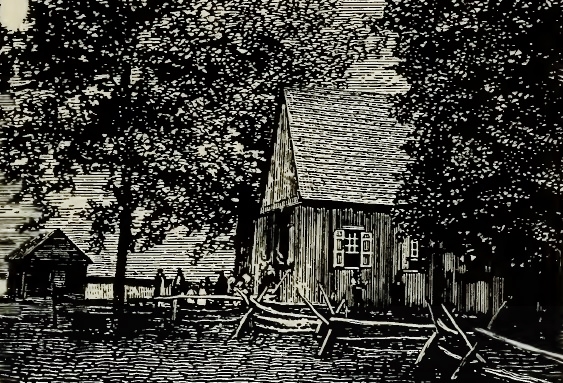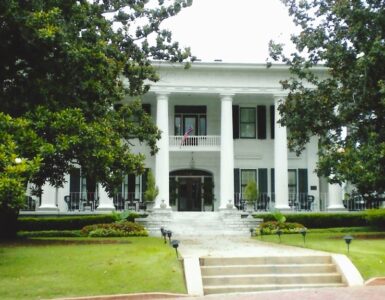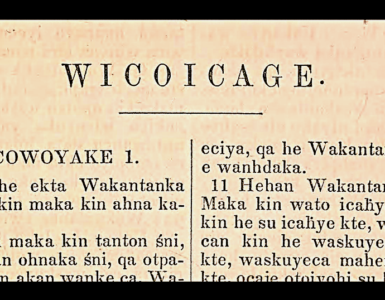Andrew Dinsmore Mitchell was born to David and Martha (Dinsmore) Mitchell in York County, Pennsylvania, February 2, 1824. His education was accomplished in Slate Ridge mostly through the teaching of Rev. A. P. Happer and a local teacher named J. D. Scott who prepared him for studies in Jefferson College where he graduated in 1841. During the next three years he earned a living teaching in a local school and attended the Slate Ridge Church where he became a member on profession of faith. At some point he decided to study for the ministry at Princeton Seminary beginning in 1844 with fifty-eight other students including one of Archibald Alexander’s sons, Samuel Davies. Andrew completed studies for the divinity certificate in 1847 shortly after being licensed by the Presbytery of Donegal in April.
 After serving a three-year licensure, Mitchell was called to pastor both the Paxton and Derry Churches in the Presbytery of Carlisle. The two congregations had been linked in ministry for a number of years. Andrew was ordained and installed on April 10, 1850. As the years of service passed, work with the Derry Church demanded less of his time because the congregation dwindled leaving him with more time to concentrate on ministry to the Paxton flock. He was the first minister of the Paxton church to enjoy the benefit of living in the manse that was completed in 1856. One Sunday morning, Rev. Mitchell and the congregation entered the church to find that part of the ceiling had fallen in. The worshippers were not thwarted from holding their service. They decided to move outside under some near-by oaks for their meeting. The benches were dug out from under the debris and set under the trees. During the last years of his ministry in Paxton the congregation dwindled due to members passing away, moving to Harrisburg, or seeking new lives on the western frontier. After a call of nearly twenty-four years, Rev. Mitchell was released from his charge by Carlisle Presbytery on February 12, 1874. A historian of the Paxton Church has commented on the ministry of Rev. Mitchell.
After serving a three-year licensure, Mitchell was called to pastor both the Paxton and Derry Churches in the Presbytery of Carlisle. The two congregations had been linked in ministry for a number of years. Andrew was ordained and installed on April 10, 1850. As the years of service passed, work with the Derry Church demanded less of his time because the congregation dwindled leaving him with more time to concentrate on ministry to the Paxton flock. He was the first minister of the Paxton church to enjoy the benefit of living in the manse that was completed in 1856. One Sunday morning, Rev. Mitchell and the congregation entered the church to find that part of the ceiling had fallen in. The worshippers were not thwarted from holding their service. They decided to move outside under some near-by oaks for their meeting. The benches were dug out from under the debris and set under the trees. During the last years of his ministry in Paxton the congregation dwindled due to members passing away, moving to Harrisburg, or seeking new lives on the western frontier. After a call of nearly twenty-four years, Rev. Mitchell was released from his charge by Carlisle Presbytery on February 12, 1874. A historian of the Paxton Church has commented on the ministry of Rev. Mitchell.
Mr. Mitchell was a man of bright mind and genial nature; an excellent pastor and much liked by the people. He was a good Scriptural preacher, and though he may have lacked initiative somewhat, was an earnest, faithful man, who can scarcely be held responsible for the weakened condition of the church during his later years.
The mention of Rev. Mitchell lacking “initiative somewhat” may indicate a factor he weighed as he made the decision to leave the church. Given the demise of Derry and the dwindling of Paxton churches, it seems that some attributed the problem to Rev. Mitchell. In some of the biographies posted on Presbyterians of the Past it has been seen that ministers sometimes continued their calls for thirty, forty, or even fifty years, however, not every minister is suited for an extended ministry to the same congregation and longevity of call does not necessarily indicate a successful pastorate.
Rev. Mitchell’s next ministry required a transition at the age of fifty-two from ministry to a local church to serving as a chaplain in the United States Army. During the Civil War entire companies of Union soldiers had sometimes attended the Paxton Church for morning worship and in the evenings Mitchell often held services at near-by Camp Curtin. Maybe his decision to become a chaplain developed from an interest in helping soldiers spiritually during the Civil War, or possibly problems he faced in the final days of his pastorate discouraged him from a local church ministry. Regardless of his motivation for serving in the military, he was appointed a chaplain in the United States Army by his Pennsylvania friend, Secretary of War James D. Cameron who served during President Grant’s troubled second term.
 Chaplain Mitchell arrived at his post in Kansas in June 1876, which was the same month that Custer and his troops were killed at the Little Big Horn in the Dakota Territory. He was to minister in the recently completed United States Military Prison at Fort Leavenworth. The new fort was constructed on the Santa Fe Trail in 1827 and named for Col. Henry Leavenworth. Mitchell found that some haphazard efforts had been made to help the prisoners spiritually but more work and organization were needed. Further, he found that the prison did not have a chapel, school, or library, all of which were included in the U. S. Army’s list of responsibilities for chaplains. As he worked in the prison, Mitchell found that personal visits with the inmates were beneficial “to learn their character,” “gain their confidence,” and counsel them according to their needs. The few years he worked as a teacher between college and seminary provided valuable experience for establishing a school for the prisoners, but he found that holding classes was not practical. He did what he could by distributing text books and writing materials to the inmates that wanted to learn, and he asked literate prisoners to tutor others who sought help with their studies. By the time Chaplain Mitchell left the prison in 1881 for a new assignment he had not only developed his tutorial program but built a library of nearly 800 volumes. Also during his Leavenworth duty Mitchell was able to have space set aside for a chapel. His successor, John B. McCleery, continued Mitchell’s tutoring program until 1888 when he opened the school that Mitchell had desired (Stover, 86).
Chaplain Mitchell arrived at his post in Kansas in June 1876, which was the same month that Custer and his troops were killed at the Little Big Horn in the Dakota Territory. He was to minister in the recently completed United States Military Prison at Fort Leavenworth. The new fort was constructed on the Santa Fe Trail in 1827 and named for Col. Henry Leavenworth. Mitchell found that some haphazard efforts had been made to help the prisoners spiritually but more work and organization were needed. Further, he found that the prison did not have a chapel, school, or library, all of which were included in the U. S. Army’s list of responsibilities for chaplains. As he worked in the prison, Mitchell found that personal visits with the inmates were beneficial “to learn their character,” “gain their confidence,” and counsel them according to their needs. The few years he worked as a teacher between college and seminary provided valuable experience for establishing a school for the prisoners, but he found that holding classes was not practical. He did what he could by distributing text books and writing materials to the inmates that wanted to learn, and he asked literate prisoners to tutor others who sought help with their studies. By the time Chaplain Mitchell left the prison in 1881 for a new assignment he had not only developed his tutorial program but built a library of nearly 800 volumes. Also during his Leavenworth duty Mitchell was able to have space set aside for a chapel. His successor, John B. McCleery, continued Mitchell’s tutoring program until 1888 when he opened the school that Mitchell had desired (Stover, 86).
 Mitchell was transferred to Fort Grant, Arizona Territory, in the fall of 1881 where shortly thereafter he died of apoplexy on March 26, 1882. He was fifty eight years old. Mitchell is buried in the Santa Fe National Cemetery in New Mexico. He had married, October 25, 1854, Miss Mary Fisher Wiestling, daughter of B. J. Wiestling, M. D., of Middletown, Pennsylvania. Mary and their only child, a son, survived Chaplain Mitchell.
Mitchell was transferred to Fort Grant, Arizona Territory, in the fall of 1881 where shortly thereafter he died of apoplexy on March 26, 1882. He was fifty eight years old. Mitchell is buried in the Santa Fe National Cemetery in New Mexico. He had married, October 25, 1854, Miss Mary Fisher Wiestling, daughter of B. J. Wiestling, M. D., of Middletown, Pennsylvania. Mary and their only child, a son, survived Chaplain Mitchell.
The son of Andrew and Mary, Benjamin Wiestling Mitchell, went on to earn his undergraduate and masters degrees from Princeton University and then later was given an honorary Ph.D. by Washington and Jefferson College. He became the head of the Department of Ancient and Modern Languages in Central High School, Philadelphia, and author of Essentials of Latin, 1899, Elements of Latin, 1912, The Writing of Narrative Latin, 1915, and Teachers’ Handbook for use with the Writing of Narrative Latin, 1916. Benjamin was a man of varied interests because he was also an associate editor of Field and Stream magazine and a member of the Philadelphia Yacht Club. He published Trail Life in the Canadian Rockies, 1924, which described his experiences during nine summers of hiking. Benjamin was also a football fan because he commented wryly in a Princeton University alumni publication that the rules of football should be changed so Princeton could enjoy an undefeated season.
BARRY WAUGH
Sources—The quote about Rev. Mitchell’s service to the Derry and Paxton congregations is from, Helen B. Wallace, ed., Historic Paxton, Her Days and Her Ways, 1722-1913, privately printed, 1913. Some of the information about Mitchell is from the Princeton Seminary necrological report for the year of his death and from the biographical catalog for 1894. “Stover” is Earl S. Stover, who wrote Up from Handymen: The United States Army Chaplaincy, 1865-1920, Washington: Office of the Chief of Chaplains, Department of the Army, 1977, which is vol. 3, of a series. The photo of Chaplain Mitchell’s grave was taken October 1, 2006, by K. Martin as was posted in Mitchell’s entry on Find a Grave; note that his last name is misspelled on the marker. The picture of the building with the fence shows Ft. Leavenworth in 1875. Information about Benjamin Mitchell was found in, Twenty Years After: Record and Directory of the Class of 1883, Princeton University, New York: Compiled and Edited by the Committee, 1904; this book also has a portrait of Benjamin.
Notes—“Apoplexy” is unconsciousness or incapacity resulting from a cerebral hemorrhage or stroke. Some sources say that Mitchell was born in 1829, which means he would have entered seminary when he was 15 years old; the 1824 date is the more reasonable selection and is attested to by more sources. In an online handbook for Central High School, Benjamin W. Mitchell is listed on the faculty and his books are listed on WorldCat.





